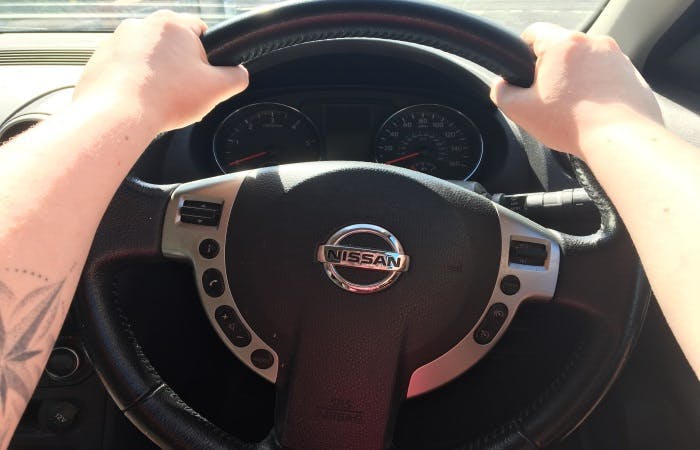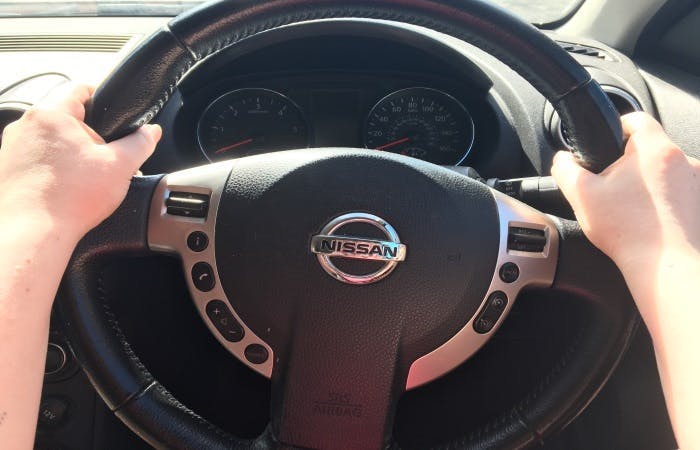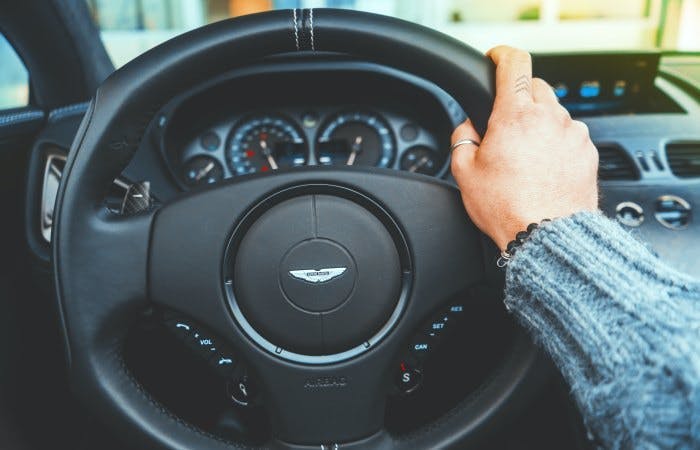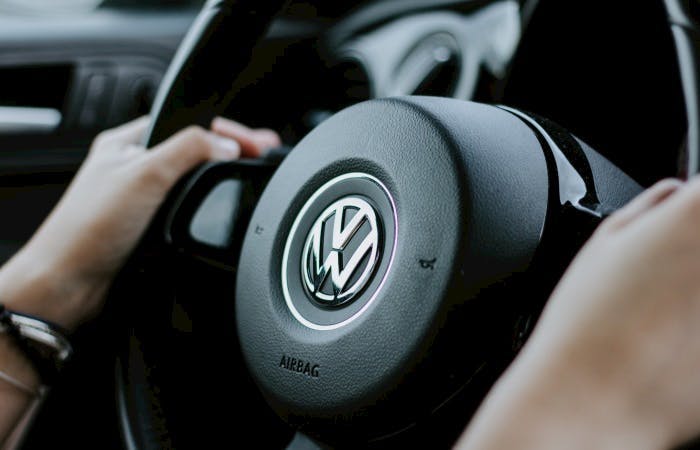
Before you can hope to get out and about on the road, you've first got to get to grips with your steering techniques. Though it might sound simple enough, some learners spend multiple lessons trying to adjust to using the steering wheel—fumbling with their hands and not knowing how to grip it properly. If you rush past this elementary skill without truly grasping it, you're only going to set yourself back. After all, you need to nail the basics before you can hope to move onto the more advanced skills. So, where do you start with steering a car?
We've put together a simple how-to guide that will take you through everything you need to know in order to steer a car safely and effectively. Get the full lowdown below!
Getting used to the steering wheel
At the beginning of your first driving lesson, your instructor will mainly focus on the basic aspects of driving. They'll start things off by walking you through the cockpit drill. Once you're properly set up behind the wheel and comfortable with the pedals, they'll then move onto getting you used to the clutch pedal. You'll likely spend a good chunk of the lesson wrapping your head around the biting point.
You won't actually start using the steering wheel properly until the instructor decides to move you onto driving around a quiet, residential estate. As you drive, your instructor will interject with a few tips to help steering feel a bit more natural. It may take you a few hours to hone your steering skills—adjusting to the movements needed to turn into a junction, park the car and complete the manoeuvres.
Steering a car: hand positions
If you're not at all familiar with driving yet, you might simply assume that you can place your hands anywhere on the steering wheel, as long as you're using both. If you're a bit more informed, however, you've likely heard of hand positions that relate to the positions on a clock. Don't worry if you think it's getting a bit complex. There are only two positions that you need to be aware of.
10 and 2

In this position, you'll place your left hand at 10 o'clock on the steering wheel and your right hand at 2 o'clock. This is one of the standard hand positions favoured by driving instructors. Though your hands will of course move as you turn, this is where they should rest otherwise.
If you're using 10 and 2, you might find yourself needing to move your seat closer to the steering wheel in order to comfortably hold your hands at this position. It's for this reason that you need to run through the cockpit drill before setting off anywhere. You need to adjust your seat so that you can easily rest your hands on the steering wheel, all the while reaching the pedals.
9 and 3

In this position, your left hand will rest at 9 o'clock and your right hand will rest at 3 o'clock. This position is slightly more relaxed than the 10 and 2. You won't find your shoulders tensing as much and it will allow you to keep your arms relatively loose. In this position, you might need to move the seat further away.
Though you won't be penalised for not using either position when using the steering wheel during the driving test, it's still a standard that you should follow. It doesn't really matter which position you opt for. It's all down to your own personal comfort.
Steering a car: on the move
Once you've picked the most comfortable hand position for you, it's now time for you to start moving! This is where it can get slightly confusing for learners. As you turn the wheel, your first impulse will likely be to start crossing your arms over the other. As you'll find out, however, the correct technique to use is the pull and push method. This will help you keep track of how much you've turned the wheel and will also ensure you maintain complete control of the vehicle at all times.
The pull and push method
Let's say that you're getting ready to turn into a junction on your left. Your hands are currently at 10 and 2, or 9 and 3. To start, you'll need to move your hands to the top of the steering wheel at 12 o'clock. Next, working simultaneously, your left hand will pull the wheel until it's resting at 6 o'clock and your right hand will slide down to rest at the same position. Then, your right hand will push the steering wheel back up to 12 o'clock while your left hand slides up to rest at the same position. (If you need to make a right-hand turn, it's the exact same as above, just in reverse.)
Once you've turned as much as you need to, you'll need to straighten up the steering wheel. You'll do this by reversing the process—using your right hand to pull the wheel down to 6 o'clock and then your left hand to push it back up to 12 o'clock.
When using this method, you'll notice that your hands will always end up meeting at the top or at the bottom of the steering wheel. One hand will be doing the hard work, pushing or pulling the steering wheel, whilst the other will simply be mirroring the gesture in a loose fashion.
Steering a car: tips and tricks

Once you've mastered the pull and push method, you'll finally be able to change lanes, turn into junctions and pull over with little-to-no effort. Go you! Before you rush off, though, there are a few additional situations that will require you to alter your steering technique ever so slightly...
Reversing
Nothing quite befuddles learners as much as steering in reverse. When the instructor finally moves you onto the reverse gear, you'll probably spend a minute or so staring at them in utter confusion. Which way are you supposed to steer if you're reversing the car? Well, it's actually more simple than you'd expect—you just steer in the direction you want to go in. If you're trying to reverse left, then turn the wheel left. If you want to go right, then turn right.
When you're steering in reverse, you need to constantly check your car mirrors and blindspots in order to make sure there aren't any stray road users nearby. When you're turning your head to check your blindspots, you might need to place your left arm over the passenger seat next to you in order to twist your torso at a more comfortable angle. In this situation, you'll want to keep your right hand firmly at 12 o'clock.
Driving at different speeds
When you first start refining your steering technique, you'll likely be situated in the middle of a quiet residential estate. This means that you'll be sticking to lower speeds—probably at about 20mph. Once your instructor thinks you're ready, however, you'll move onto roads with higher speed limits. When this happens, you'll need to be prepared to switch up your steering style.
Driving at low speeds requires you to put in quite a bit of effort when steering and turning into junctions. When you're travelling at a higher speed, however, you'll find that you don't need to use as much force with the wheel—you'll only need to turn it in small increments to change lanes. Try to bear this in mind when you're driving.
Parking and manoeuvring
When you're parking your car, you'll ideally want all of your wheels to face forward. In order to achieve this, you'll need to make sure that you straighten up the steering wheel before stopping the car. If you're parking uphill, however, you'll want to turn the steering wheel slightly so that your wheels are facing slightly away from the kerb. If you're parking downhill, you'll need to steer so that the wheels are facing slightly towards the kerb.
If you want to carry out a manoeuvre safely and effectively, your steering technique will need to be on point. The slightest mistake with your steering can ruin a manoeuvre—earning you a minor or major fault during the driving test. To make sure you know how you should be steering, and at what speed, we'd recommend reading our manoeuvre guides:
Steering: Dos and Don'ts

DO pay attention to your grip
If you're a nervous driver, or you haven't had any experience behind the wheel, the temptation is usually to grip the steering wheel as tightly as possible. This is something that you'll want to avoid. For starters, you'll wear out your hands. You'll also make it difficult to use the pull and push method—one of your hands needs to hold the wheel in a loose fashion in order to slide up or down.
DON'T attempt to dry steer
If you've stopped your car, only to realise that your wheels aren't straight, you might try to straighten up the steering wheel. What you might not realise, however, is that this is called dry steering. You should never try to steer your car when it's stationary. Doing so will severely damage your tyres. If you need to straighten up your wheels, then start the car and make your adjustments.
DO try to use both hands
Though you won't be penalised for steering with one hand in your test, it's good to get into the habit of using two hands—it's a much safer practice. It's for this reason that most car controls are located around the steering wheel. It minimises the amount of time that you're driving with only one hand. So, keep both hands on the steering wheel and only switch to one if you need to change gears, use a control or reverse.
DON'T let go of the steering wheel
Once you've completed a turn into a junction, you need to turn the steering wheel back to its original position. Some learners opt to do this by simply letting go of the steering wheel and allowing it to move itself back. Do not do this. If you let go of the wheel, you run the risk of losing control of the car. If you do this in your driving test, you can definitely expect to pick up a minor fault!
DO look straight ahead
If you've been struggling to get to grips with the pull and push method, you might find yourself glancing down at your hands every few seconds in order to make sure you're moving them into the right position. This should be avoided. You need to keep both eyes on the road ahead of you in order to steer clear of any potential hazards. If you keep glancing down, you're going to miss something.
DON'T forget to practise
Still can't quite wrap your head around steering? Try practising at home instead! You can do this easily enough with a dinner plate. Just hold it as you would a steering wheel and practise going through the pull and push method. If you're a bit clumsy, you can forgo the plate and just do it in thin air. It might look silly, but the repeated motion will solidify your muscle memory and help you become a pro in no time!
Subscribe for driving advice, offers & more
We'd love to let you know about our courses, news and offers via email. You may unsubscribe at any time.
Star Genie Limited trading as PassMeFast. Company number 10093359
Copyright © 2024 owned by Star Genie Limited
PassMeFast, Blue Tower, MediaCityUK, Salford, M50 2ST
